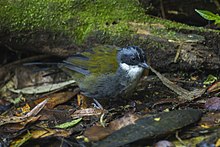White-browed brushfinch
| White-browed brushfinch | |
|---|---|

| |
| Scientific classification | |
| Kingdom: | |
| Phylum: | |
| Class: | |
| Order: | |
| Family: | |
| Genus: | |
| Species: | A. torquatus
|
| Binomial name | |
| Arremon torquatus (Lafresnaye & d'Orbigny, 1837)
| |
| Synonyms | |
|
Buarremon torquatus (Lafresnaye & D'Orbigny, 1837) | |
The white-browed brush finch (Arremon torquatus) is a species of bird in the Emberizidae family. It is found in north-western Argentina, Bolivia, and southern Peru. It is generally common in forest and dense second growth, mainly at altitudes of 2,000 to 3,000 metres (6,600 to 9,800 ft), but locally it occurs at far lower altitudes.[2] It previously was considered the nominate subspecies of the stripe-headed brush finch.
Taxonomy
Until recently, the white-browed brush finch was placed in the genus Buarremon.[3]
Considerable racial variation existed in the formerly named stripe-headed brush finch, and based on ecology, morphology, song, and molecular work it was recently suggested that it be split into eight species.[4]
References
- ^ Template:IUCN
- ^ Ridgely, R. S., & G. Tudor. (1989). Birds of South America. The Oscine Passerines. Vol. 1. Oxford University Press. ISBN 0-19-857217-4
- ^ Cadena, C. D., J. Klicka and R. E. Ricklefs. (2007). Evolutionary differentiation in the Neotropical montane region: molecular phylogenetics and phylogeography of Buarremon brush-finches (Aves, Emberizidae). Molecular Phylogenetics and Evolution. 44(3): 993-1016.
- ^ Cadena, C. D., and A. M. Cuervo (2009). Molecules, ecology, morphology, and songs in concert: how many species is Arremon torquatus (Aves: Emberizidae)? Biological Journal of the Linnean Society 99(1): 152-176
- South American Classification Committee (September 2010). "Proposal (#468) to South American Classification Committee – Species limits in Arremon torquatus". Retrieved July 24, 2012.

